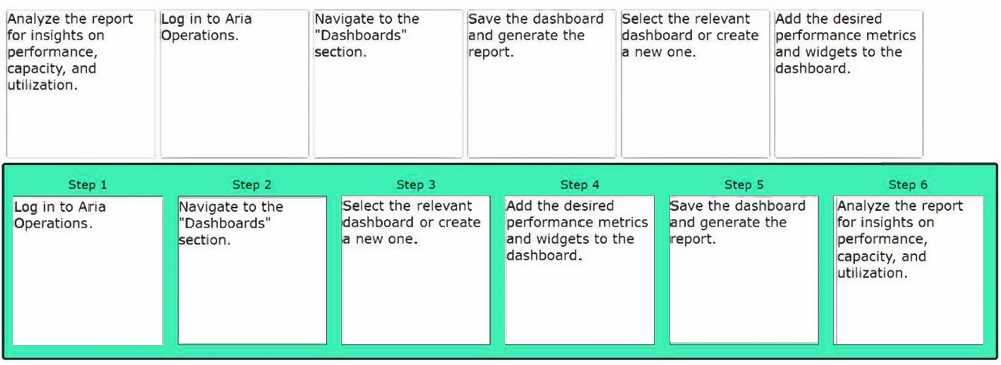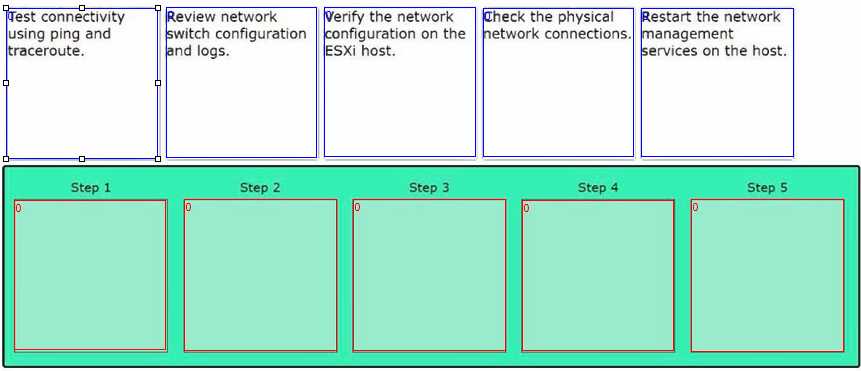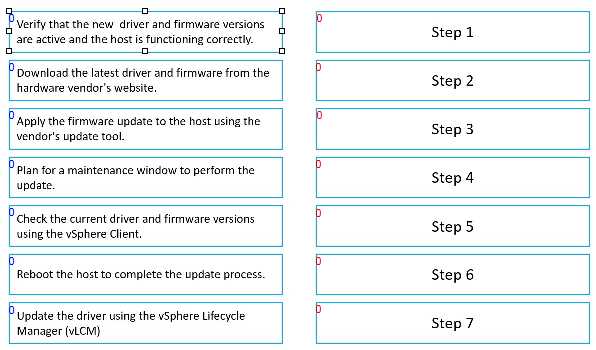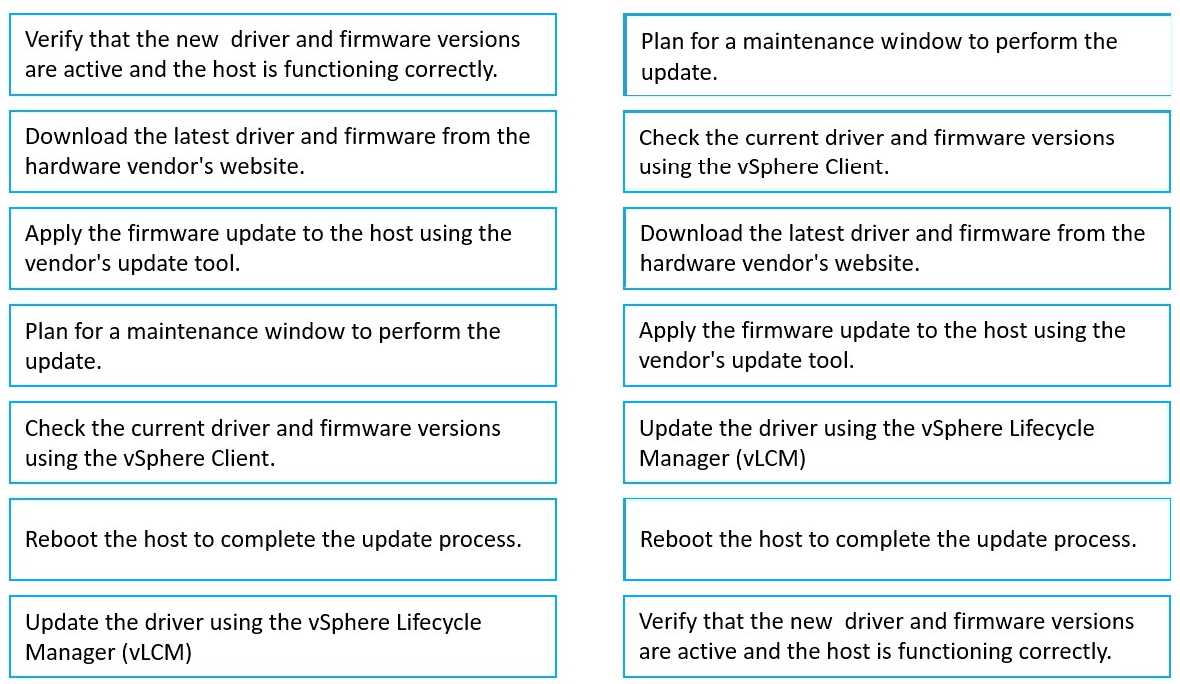VMware 2v0-11-24 practice test
VMware Cloud Foundation 5.2 Administrator Exam
Question 1
DRAG DROP
Put the following steps in the correct order to optimize resource allocation using Aria Operations.
Answer:
Explanation:
Question 2
DRAG DROP
Match each troubleshooting task with its relevant procedure or tool.
Answer:
Explanation:
Question 3
DRAG DROP
Arrange the steps in the correct order to generate a performance report in Aria Operations.
Answer:
Explanation:
Question 4
DRAG DROP
Arrange the steps in the correct order to resolve host connectivity issues.
Answer:
Explanation:
Question 5
DRAG DROP
Match each networking issue with the corresponding troubleshooting step.
Answer:
Explanation:
Question 6
DRAG DROP
Put the following steps in the correct order to update the driver/firmware in vSAN.
Answer:
Explanation:
Question 7
DRAG DROP
Match each vSphere HA host state issue with its troubleshooting step.
Answer:
Explanation:
Question 8
An administrator needs to ensure that network traffic is protected from interception and tampering
during VM migration activities. What feature or setting should the administrator enable to achieve
this?
- A. Encrypted vSphere vMotion
- B. vSphere Virtual Machine Encryption
- C. vSphere DRS
- D. vSphere HA
Answer:
A
Explanation:
Encrypted vSphere vMotion ensures that network traffic is protected from interception and
tampering during VM migration activities by encrypting the vMotion traffic. This feature secures the
transfer of virtual machines across hosts in the vSphere environment.
Question 9
What is the primary use case for Aria Operations within the VMware Aria Suite?
- A. To manage and analyze log data from various sources
- B. To enable network virtualization and security.
- C. To automate workload deployments across multiple cloud environments.
- D. To provide comprehensive monitoring, analytics, and performance management of the cloud infrastructure.
Answer:
D
Explanation:
Aria Operations (formerly known as vRealize Operations) is used to monitor, analyze, and manage
the performance of cloud infrastructures, providing insights into capacity, utilization, and overall
health. It helps in optimizing resources, preventing downtime, and ensuring the smooth running of
applications and services in a VMware environment.
Question 10
An administrator is tasked with enabling Workload Management (vSphere IaaS control plane) on a
VMware Cloud Foundation workload domain.
Which three of the following are prerequisites for enabling Workload Management? (Choose three.)
- A. Ensure that the cluster has at least three ESXi hosts.
- B. Configure NTP and DNS settings for all management components.
- C. Install the vSphere Client on all ESXi hosts.
- D. Verify that all ESXi hosts are running vSphere 7.0 or later.
Answer:
A, B, D
Explanation:
For Workload Management in VMware Cloud Foundation, a minimum of three ESXi hosts is required
to create a robust, highly available vSphere cluster.
Proper NTP and DNS configuration is essential to ensure time synchronization and proper resolution
of network names, which are critical for Workload Management.
The hosts must be running vSphere 7.0 or later to be compatible with the latest features and
requirements for Workload Management.
Question 11
What is the primary purpose of configuring a Key Management Server (KMS) in vCenter for VM
Encryption?
- A. To provide high availability for virtual machines.
- B. To manage encryption keys for securing VM data.
- C. To monitor network traffic for VMs.
- D. To optimize the performance of encrypted VMs.
Answer:
B
Explanation:
The primary purpose of configuring a Key Management Server (KMS) in vCenter for VM Encryption is
to manage and store the encryption keys that are used to secure virtual machine data. The KMS
ensures that encryption keys are handled securely and provides a central management point for
encrypting VMs in a VMware environment.
Question 12
An alert in SDDC Manager indicates that the health status of the vSAN cluster is degraded.
Which tool within VMware Cloud Foundation should be used to gather detailed logs and perform in-
depth troubleshooting for the vSAN issues?
- A. Aria Operations for Logs
- B. SDDC Manager
- C. vCenter Server
- D. Aria Operations for Networks
Answer:
A
Explanation:
Aria Operations for Logs (formerly known as vRealize Log Insight) is used to collect, analyze, and
troubleshoot logs from various components within VMware Cloud Foundation, including the vSAN
cluster. It provides detailed insights into the logs, allowing administrators to perform in-depth
troubleshooting of issues like degraded health statuses.
Question 13
An administrator needs to configure and manage storage resources and policies to optimize
performance of a VCF environment configured with vSAN.
What two steps should the administrator take? (Choose two.)
- A. Enable vSphere HA to ensure high availability and resource distribution.
- B. Monitor the vSAN performance service for insights into the performance issues.
- C. Analyze the current vSAN storage policies and adjust them as needed.
- D. Disable vSAN health alerts to reduce administrative overhead.
- E. Decrease the number of disk groups per host to improve performance.
Answer:
B, C
Explanation:
The vSAN performance service provides valuable insights into the storage performance, helping
identify potential bottlenecks or areas for improvement.
Analyzing and adjusting vSAN storage policies is crucial for ensuring optimal performance. Policies
such as RAID levels, storage encryption, and other settings can be tweaked to better match the
environment's performance requirements.
Question 14
A specific VM is unable to communicate with other VMs in the same network. An administrator
needs to identify and resolve the network connectivity issue.
What three steps should the administrator follow? (Choose three.)
- A. Verify the port group settings and VLAN configuration
- B. Use the ESXi command line to check the status of the VM Kernel adapter
- C. Verify that the VM is connected to the correct port group
- D. Check the network adapter settings in vCenter Server
- E. Restart the VM to reset its network connections
Answer:
A, C, D
Explanation:
Port group settings and VLAN configurations need to be correct for VMs to communicate with each
other on the same network. Ensuring they are properly configured is essential.
It's important to check that the VM is connected to the correct port group that matches the network
configuration of the other VMs.
The network adapter settings in vCenter Server should be reviewed to ensure there are no
misconfigurations that could prevent network communication.
Question 15
Which VMware vSphere feature provides the ability to define and apply datastore capabilities to
ensure virtual machines meet specific performance and availability requirements?
- A. Storage Policy Components
- B. Storage Policies
- C. Performance Service
- D. Host Profiles
Answer:
B
Explanation:
Storage Policies in VMware vSphere allow administrators to define and apply specific storage
requirements for virtual machines, ensuring they meet desired performance and availability
standards. These policies enable the alignment of VM storage needs with the capabilities of the
underlying datastores.